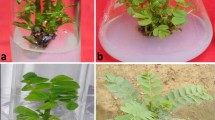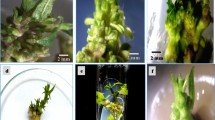Abstract
An efficient and improved plant regeneration protocol has been developed from nodal explants of Ocimum canum Sims., a medicinally important herbaceous plant species belonging to the family Lamiaceae. Murashige and Skoog (MS) basal medium supplemented with 0.5 mg l−1 N6-benzyladenine (BA) showed maximum percentage of shoot multiplication (91.1 %) with 5.32 shoots per explant. Rooting of shoots occurred on 1/2 MS medium supplemented with 1.0 mg l−1 indole-3-butyric acid (IBA). Well-developed plantlets, transferred to plastic pots containing sand, soil and compost (2:2:1) showed 80.9 % survival rate under field condition. The genetic fidelity of in vitro raised field-grown plants to the donor plant was ascertained from histological, cytological and two PCR based molecular markers, i.e., random amplified polymorphic DNA (RAPD) and inter-simple sequence repeat (ISSR). Histological study showed direct organogenesis on epidermal and sub epidermal layer, where as cytological studies showed no visible anomalies within its chromosome compliments. Both RAPD and ISSR analysis revealed high degree of monomorphism, similar to those of the mother plants. This method of in vitro clonal propagation of O. canum Sims. may, therefore, could be an avenue of its sustainable commercial exploitation and conservation.



Similar content being viewed by others
References
Ahuja, A., Verma, M., & Grewal, S. (1982). Clonal propagation of Ocimum species by tissue culture. Indian Journal of Experimental Biology, 20(6), 455–458.
Begum, F., Amin, M. N., & Azad, M. A. K. (2002). In vitro rapid clonal propagation of Ocimum basilicum L. Plant Tissue Culture, 12(1), 27–35.
Bhaskaran, P., & Jayabalan, N. (2005). An efficient micropropagation system for Eclipta alba–a valuable medicinal herb. Vitro Cellular & Developmental Biology-Plant, 41(4), 532–539.
Duncan, D. B. (1955). Multiple range and multiple F test. Biometrics, 11(1), 1–42.
Gopi, C., Sekhar Nataraja, Y., & Ponmurugan, P. (2006). In vitro multiplication of Ocimum gratissimum L. through direct regeneration. African Journal of Biotechnology, 5(9), 723–726.
Hassane, S. O. S., Farah, A., Satrani, B., Ghanmi, M., Chahmi, N., Soidrou, S. H., et al. (2012). Chemical Composition and Antimicrobial Activity of Comorian Ocimum canum Essential Oil Harvested in the Region of Maweni Dimani-Grande Comoros. In M. B. Gupta, S. Jhaumeer-Laulloo, H. Li Kam Wah, & P. Ramasami (Eds.), Chemistry for Sustainable Development (pp. 443–452). Springer: New York.
Jayaseelan, C., & Rahuman, A. A. (2012). Acaricidal efficacy of synthesized silver nanoparticles using aqueous leaf extract of Ocimum canum against Hyalomma anatolicum anatolicum and Hyalomma marginatum isaaci (Acari: ixodidae). Parasitology Research, 11(3), 1369–1378.
Martins, M., Sarmento, D., & Oliveira, M. M. (2004). Genetic stability of micropropagated almond plantlets, as assessed by RAPD and ISSR markers. Plant Cell Reports, 23(7), 492–496.
Murashige, T., & Skoog, F. (1962). A revised medium for rapid growth and bioassays with tobacco tissue cultures. Physiologia Plantarum, 15(3), 473–497.
Murray, M. G., & Thompson, E. F. (1980). Rapid isolation of high molecular weight plant DNA. Nucleic Acids Research, 8(19), 4321–4325.
Nissen, S. J., & Sutter, E. G. (1990). Stability of IAA and IBA in nutrient medium to several tissue culture procedures. HortScience, 25(7), 800–802.
Nyarko, A. K., Asare-Anane, H., Ofosuhene, M., & Addy, M. E. (2002). Extract of Ocimum canum lowers blood glucose and facilitates insulin release by isolated pancreatic beta-islet cells. Phytomedicine, 9(4), 346–351.
Paton, A., Harley, M. R., & Harley, M. M. (1999). Ocimum: an overview of relationships and classification. In R. Hiltunen & Y. Holm (Eds.), Basil: the genus Ocimum (p. 38). Amsterdam: Harwood.
Pattnaik, S., & Chand, P. K. (1996). In vitro propagation of the medicinal herbs Ocimum americanum L. syn. O. canum Sims. (hoary basil) and Ocimum sanctum L. (holy basil). Plant Cell Reports, 15(11), 846–850.
Phippen, W. B., & Simon, J. E. (2000). Shoot regeneration of young leaf explants from basil (Ocimum basilicum L.). In Vitro Cellular & Developmental Biology-Plant, 36(4), 250–254.
Premvaranon, P., Vearasilp, S., Thanapornpoong, S., Karladee, D., & Gorinstein, S. (2011). In vitro studies to produce double haploid in Indica hybrid rice. Biologia, 66(6), 1074–1081.
Saha, S., Dey, T., & Ghosh, P. D. (2010a). Micropropagation of Ocimum Kilimandscharicum Guerke (Labiatae). Acta Biologica Cracoviensia Series Botanica, 52(2), 50–58.
Saha, S., Dhar, T. N., Sengupta, C., & Ghsoh, P. D. (2013). Biological activities of essential oils and methanol extract of five Ocimum species against pathogenic bacteria. Czech Journal of Food Science, 31(2), 194–202.
Saha, S., Ghosh, P. D., & Sengupta, C. (2010b). An Efficient Method for Micropropagation of Ocimum basilicum L. Indian Journal of Plant Physiology, 15(2), 168–172.
Saha, S., Kader, A., Sengupta, C., & Ghosh, P. D. (2012). In Vitro Propagation of Ocimum gratissimum L. (Lamiaceae) and Its Evaluation of Genetic Fidelity Using RAPD Marker. American Journal of Plant Science, 3(1), 64–74.
Saha, S., Sengupta, C., & Ghosh, P. D. (2014). Molecular and phytochemical analyses to assess genetic stability in alginate-encapsulated microshoots of Ocimum gratissimum L. following in vitro storage. Nucleus, 57(1), 33–43.
Sahoo, Y., Pattnaik, S. K., & Chand, P. K. (1997). In vitro clonal propagation of an aromatic medicinal herb Ocimum basilicum L. (sweet basil) by axillary shoot proliferation. In Vitro Cellular & Developmental Biology-Plant, 33(4), 293–296.
Sathyanarayana, N., Bharath kumar, T. N., Vikas, P. B., & Rajesha, R. (2008). In vitro clonal propagation of Mucuna pruriens var. utilis and its evaluation of genetic stability through RAPD markers. African Journal of Biotechnology, 7(8), 973–980.
Senapati, S. K., Aparajita, S., & Rout, G. R. (2013). Micropropagation and assessment of genetic stability in Celastrus paniculatus: an endangered medicinal plant. Biologia, 68(4), 627–632.
Shukla, S., Shukla, S. K., & Mishra, S. K. (2009). In vitro plant regeneration from seedling explants of Stereospermum personatum D.C.: a medicinal tree. Trees, 23(2), 409–413.
Sivakumar, G., & Krishnamurthy, K. V. (2000). Micropropagation of Gloriosa superba L.: an endangered species of Asia and Africa. Current Science, 78(1), 30–32.
Skoog, F., & Miller, C. (1957). Chemical regulation of growth and organ formation in plant tissues cultured in vitro. Symposia of the Society for Experimental Biology, 54(11), 118–131.
Sudhakaran, S., & Sivashankari, V. (2002). In vitro flowering response of Ocimum basilicum L. Journal of Plant Biotechnology, 4(4), 181–183.
Viera, R. E., Fahoer, R., & Raina, S. K. (2001). Genetic Diversity of Ocimum gratissimum L. based on volatile oil constituents, flavonoids and RAPD markers. Biochemical Systematics and Ecology, 29(3), 287–304.
Acknowledgments
We are thankful to anonymous reviewers for their valuable suggestions. First author (S. Saha) wish to acknowledge the support of the University Grants Commission (UGC), New Delhi for the award of Post Doctoral Fellowship. Financial assistance provided by University Grant Commission (UGC) New Delhi, is gratefully acknowledged. We also thank to Department of Science and Technology (DST-FIST programme), Govt. of India, Department of Botany, University of Kalyani for Instrumental facilities.
Author information
Authors and Affiliations
Corresponding author
Rights and permissions
About this article
Cite this article
Saha, S., Roy, S., Sengupta, C. et al. Micropropagation and analysis of genetic stability in regenerated plantlets of Ocimum canum Sims.. Ind J Plant Physiol. 19, 174–183 (2014). https://doi.org/10.1007/s40502-014-0093-8
Received:
Accepted:
Published:
Issue Date:
DOI: https://doi.org/10.1007/s40502-014-0093-8




